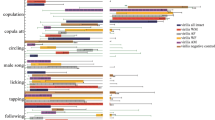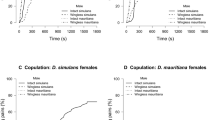Abstract
In the Drosophila melanogaster complex, females D. melanogaster mate relatively easily with males Drosophila simulans but the reciprocal cross is rare. The species sexual isolation is mainly based on chemical and acoustic signal exchanges between partners. The male side of this communication is investigated in this paper in order to understand the asymmetry. In D. melanogaster the acoustic signature is highly significant, and is synergistically reinforced by the chemical signal. In D. simulans the importance of the two signaling channels seems to be reversed. This could explain why D. simulans males produce less precise interpulse interval (IPI) mean value in the courtship song, which can readily overlap those of D. melanogaster. As the males of the two species use the same chemical key, D. simulans males could be recognized by D. melanogaster females as a conspecific.
Similar content being viewed by others
References
Antony, C., T.L. Davis, D.A. Carlson, J.M. Pechiné & J.-M. Jallon, 1985. Compared behavioral responses of male Drosophila melanogaster (Canton S) to natural and synthetic aphrodisiac. J. Chem. Ecol. 11: 1617–1629.
Ashburner, M., 1989. Drosophila. Cold Spring Harbor Laboratory Press, Cold Spring Harbor, NY.
Aubin, T., 1994. Syntana: a software for the synthesis and analysis of animal sounds. Bioacoustics 6: 80–81.
Aubin, T., F. Rybak & B. Moulin, 2000. A simple method for recording low-amplitude sounds. Application to the study of the courtship song of the fruit fly Drosophila melanogaster. Bioacoustics 11: 51–67.
Bennet-Clark, H.C. & A.W. Ewing, 1969. Pulse interval as a critical parameter in the courtship song of D. melanogaster. Anim. Behav. 17: 755–759.
Cobb, M. & J.-M. Jallon, 1990. Pheromones, mate recognition and courtship stimulation in the Drosophila melanogaster species subgroup. Anim. Behav. 39: 1058–1067.
Cobb, M., B. Burnet & K. Connolly, 1986. The structure of courtship in the Drosophila melanogaster species subgroup. Behaviour 97: 182–212.
Cowling, D.E. & B. Burnet, 1981. Courtship song and genetic control of their acoustic characteristics in sibling species of D. melanogaster subgroup. Anim. Behav. 29: 924–935.
Coyne, J.A. & R. Oyama, 1995. Localization of pheromone sexual dimorphism in Drosophila melanogaster and its effect on sexual isolation. Proc. Natl. Acad. Sci. USA 92: 9505–9509.
Ewing, A.W., 1983. Functional aspects of Drosophila courtship. Biol. Rev. 58: 275–292.
Jallon, J.-M., 1984. A few chemical words exchanged by Drosophila during courtship and mating. Behav. Genet. 14: 441–478.
Kyriacou, C.P. & J.C. Hall, 1982. The function of courtship song rhythms in Drosophila. Anim. Behav. 30: 794–801.
Lachaise, D., J.R. David, F. Lemeunier, L. Tsacas & M. Ashburner, 1986. The reproductive relationships of Drosophila sechellia with D. mauritiana, D. simulans and D. melanogaster from the afrotropical region. Evolution 40(2): 262–271.
Moulin, B., F. Rybak, T. Aubin & J.-M. Jallon, 2001. Compared ontogenesis of courtship song components of males from sibling species, D. melanogaster and D. simulans. Behav. Genet. 31: 299–308.
Paterson, H.E.H., 1985. The recognition concept of species, pp. 21–29 in Species and Speciation, edited by E.S. Vbra. Transvaal Museum, Pretoria, South Africa.
Pechiné, J.M., F. Perez, C. Antony & J.-M. Jallon, 1985. A further characterization of Drosophila cuticular monoenes using a mass spectrometry method to localize double bonds in complex mixtures. Anal. Biochem. 145: 177–182.
Pechiné, J.M., C. Antony & J.-M. Jallon, 1988. Precise characterization of cuticular compounds in young Drosophila by mass spectrometry. J. Chem. Ecol. 14: 1071–1084.
Ritchie, M.G., E.J. Halsey & J.M. Gleason, 1999. Drosophila song as a species-specific mating signal and the behavioural importance of Kyriacou & Hall cycles in D. melanogaster song. Anim. Behav. 58: 649–657.
Rybak, F., T. Aubin & G. Sureau, 2002a. Functional coupling of acoustic and chemical signals in the courtship behaviour of the male Drosophila melanogaster. Proc. R. Lond. B 269: 695–701.
Rybak, F., T. Aubin, B. Moulin & J.-M. Jallon, 2002b. Acoustic communication in Drosophila melanogaster courtship: are pulse and sine songs frequencies important for the courtship success? Can. J. Zool. 80: 987–996.
Sokal, R.R. & F.J. Rohlf, 1981. Biometry. Freeman, San Francisco, 2nd edn.
Sperlich, D., 1962. Hybrids between Drosophila melanogaster and D. simulans in nature. Drosoph. Inf. Serv. 36: 118.
Sturtevant, A.H., 1915. Experiments on sex recognition and the problem of sexual selection in Drosophila. J. Anim. Behav. 5: 351–366.
Tomaru, M., M. Doi, H. Higuchi & Y. Oguma, 2000. Courtship song recognition in the Drosophila melanogaster complex: heterospecific songs make female receptive in D. melanogaster, but not in D. sechellia. Evolution 54: 1286–1294.
Ury, H.K., 1976. A comparison of four procedures for multiples comparisons among means (pairwise contrasts) for arbitrary sample sizes. Technometrics 18: 89–97.
Von Schilcher, F., 1976. The role of auditory stimuli in the courtship of D. melanogaster. Anim. Behav. 24: 18–26.
Watanabe, T.K., W.H. Lee, Y. Inoue & M. Kawanishi, 1977. Genetic variation of the hybrid crossability between Drosophila melanogaster and D. simulans. Jpn. J. Genet. 52: 1–8.
Welbergen P., F.R. van Dijken & W. Scharloo, 1987. Collation of the courtship behaviour of the sympatric species Drosophila melanogaster and Drosophila simulans. Behaviour 101: 253–274.
Wheeler, D., W. Fields & J.C. Hall, 1988. Spectral analysis of Drosophila courtship song: D. melanogaster, D. simulans and their interspecific hybrid. Behav. Genet. 18: 675–703.
Author information
Authors and Affiliations
Corresponding author
Rights and permissions
About this article
Cite this article
Moulin, B., Aubin, T. & Jallon, JM. Why There is a One-way Crossability Between D. melanogaster and D. simulans?. Genetica 120, 285–292 (2004). https://doi.org/10.1023/B:GENE.0000017650.45464.f4
Issue Date:
DOI: https://doi.org/10.1023/B:GENE.0000017650.45464.f4




